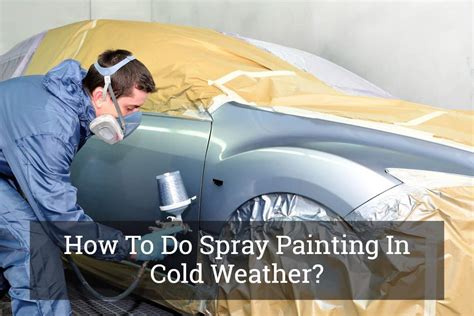Don't Let the Cold Ruin Your Project: A Spray Paint Temperature Guide
Winter's chill can throw a wrench in even the most meticulously planned DIY project. One of the biggest culprits? Spray paint. Applying spray paint in cold temperatures can lead to a host of problems, from poor adhesion and uneven coverage to a finish that's far from ideal. This comprehensive guide will equip you with the knowledge to conquer the cold and achieve a professional-looking finish, no matter the season.
What Happens When You Spray Paint in Cold Weather?
The biggest issue with using spray paint in cold temperatures is the impact on the paint's chemical properties. Cold temperatures slow down the evaporation rate of the solvents in the spray paint. This can result in:
- Poor adhesion: The paint may not properly bond with the surface, leading to peeling or chipping.
- Uneven finish: The slower evaporation can create runs, drips, and an uneven, blotchy appearance.
- Longer drying time: Expect significantly extended drying times, potentially leaving your project vulnerable to damage.
- Reduced pigment dispersion: The paint may appear duller or less vibrant than expected.
- ** Nozzle clogging:** Cold temperatures can cause the paint to thicken, leading to nozzle clogging and inconsistent spray patterns.
What is the Ideal Temperature for Spray Painting?
Most spray paint manufacturers recommend a temperature range between 60°F (15°C) and 80°F (27°C) for optimal results. However, some paints may have slightly different recommendations, so always check the label for specific instructions. Operating outside this range increases the likelihood of encountering the problems mentioned above.
What Happens if It's Too Hot?
While not as problematic as cold temperatures, extremely hot weather can also affect spray paint application. Excessive heat can cause the paint to dry too quickly, leading to a rough texture and reduced coverage. Additionally, the solvents may evaporate too quickly, potentially resulting in a thinner coat.
How to Spray Paint in Cold Weather (Without Disaster!)
Don't let the cold sideline your project! Here's how to mitigate the risks associated with low-temperature spray painting:
1. Warm Up Your Workspace and Materials:
This is crucial. Bring your project, spray cans, and even the surrounding area to a warmer temperature. Consider working inside a heated garage or workshop. Allow the spray cans to reach room temperature before use. You can even submerge them in warm (not hot!) water for about 30 minutes. Never expose spray cans to direct heat.
2. Multiple Thin Coats are Key:
Resist the urge to apply thick coats. Multiple thin coats will allow the paint to dry evenly and prevent runs or drips. Allow ample drying time between coats. Check the paint can for the recommended drying time and add additional time based on the temperature.
3. Protect Your Work Area:
Cold weather can also affect the curing time of the paint. To ensure that your project isn't disturbed or accidentally damaged during the curing process, keep the area protected from dust and moisture.
4. Choose the Right Paint:
Some spray paints are formulated to perform better in colder conditions. Check the label for specific temperature recommendations. Low-VOC paints can sometimes perform better in colder temperatures.
5. Use a Primer:
A good primer can improve adhesion and provide a better surface for the spray paint to adhere to, especially in cold conditions.
6. Light Coats and Patience:
Work in thin, even coats and move the spray can smoothly and consistently, to allow for better distribution. Be patient and allow ample time for drying between coats.
Frequently Asked Questions (PAAs)
Q: Can I use a heat gun to warm up the spray paint?
A: No, avoid using a heat gun or other direct heat sources on spray cans. This can cause the cans to explode. Gentle warming in warm water is the safest approach.
Q: What temperature is too cold to spray paint?
A: While there's no single magic number, anything below 50°F (10°C) significantly increases the risk of problems. Below freezing (32°F/0°C), it's generally not recommended.
Q: Will my spray paint still dry if it's cold?
A: Yes, it will dry, but much more slowly and with a higher chance of issues. Follow the tips above to optimize drying.
Q: Does the humidity affect spray paint application in cold weather?
A: Yes, high humidity can further impede drying and increase the risk of uneven finishes in cold temperatures. Ideally, aim for lower humidity conditions.
Q: Can I use a spray booth in cold weather?
A: A heated spray booth will greatly improve your chances of success, offering temperature control and dust protection.
By following these guidelines, you can successfully navigate the challenges of cold-weather spray painting and achieve professional-looking results. Remember, patience and preparation are key to preventing costly mistakes and ensuring your project’s success.

